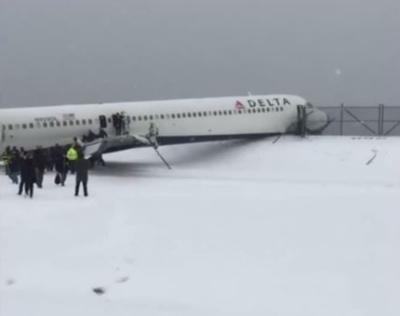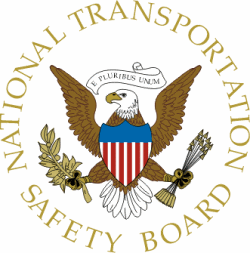Two Additional Investigative Groups Formed
?As part of its ongoing investigation into the March 5, 2015 accident at LaGuardia Airport where Delta Air Lines flight 1086 veered off the runway shortly after touching down, the NTSB has released its third investigative update.

At about 11:02 a.m., the Boeing MD-88, flying from Atlanta, GA to New York, NY, exited the left side of runway 13, struck a perimeter fence with its left wing, and came to rest with its nose on an embankment. There were 127 passengers on the aircraft, including two infants carried on adults’ laps, as well as five crewmembers. Twenty-three passengers suffered minor injuries.
The NTSB has formed two additional investigative groups that will investigate Airport Operations and Survival Factors. Existing groups include Operations and Human Performance, Airplane Performance, Flight Data Recorder, Cockpit Voice Recorder, and Maintenance Records.
The Airport Operations group will document the snow-clearing plan in place at LaGuardia Airport and document snow clearing operations the day of the accident. Thus far, the group was provided information indicating that runway 13 was cleared approximately 20-25 minutes prior to the accident.
The Survival Factors group will document the cabin safety aspects of the accident, and the emergency evacuation of the accident airplane.
The Airworthiness group has completed its initial examination of the accident airplane. Several components have been removed from the accident airplane for further examination and testing. At this point, no pre-impact anomalies have been noted in the airplane structure, spoilers, thrust reversers, or braking system.
The Operations group has found that four airplanes landed on runway 13 between the conclusion of snow-clearing operations at about 10:40 local time and the accident flight. It also determined that the airplane that landed three minutes before the accident flight was another Delta MD-88 airplane. The group has interviewed or obtained statements from all four flight crews. The group reviewed the Delta MD-88 pilot operational materials and found guidance to limit reverse engine pressure ratios (EPR) to 1.3 on contaminated runways.

The Airplane Performance group continues to examine data from the FDR, ATC radar, weather, and ground scar information to determine the timeline of aircraft motion, pilot control inputs and forces acting on the airplane. Based on a preliminary readout and examination of the FDR data from the Flight Data Recorder group and preliminary calculations from the Airplane Performance group:
- The airplane was aligned with the runway centerline during the approach to the runway.
- The autopilot was engaged until the airplane was about 230 feet above the ground.
- The airspeed during the final approach was about 140 knots.
- The main landing gear touched down close to the runway centerline, at a speed of about 133 knots.
- Two seconds after main gear touchdown both thrust reversers were deployed and engines began advancing in power.
- The spoilers were fully deployed within 2.5 seconds after main gear touchdown.
- The nose gear touched down and brake pressure began to rise in a manner consistent with autobrake application 2.8 seconds after the main gear touchdown.
- About six seconds after main gear touchdown, the airplane’s heading began to diverge to the left. At this point, both the left and right engine EPR were about 1.9 with the reversers still deployed.
- The engines reached peak recorded reverse thrust of 2.07 EPR on the left, and 1.91 EPR on the right, between six and seven seconds after touchdown. Engine thrust decreased after this point.
- The thrust reversers were stowed nine seconds after main gear touchdown when the engines were both at about 1.6 EPR.
- The airplane departed the left side of the runway approximately 14 seconds after main gear touchdown.
The investigation is ongoing and any future updates will be issued as events warrant.
(Image from file)
 ANN's Daily Aero-Term (12.08.25): Decision Altitude (DA)
ANN's Daily Aero-Term (12.08.25): Decision Altitude (DA) ANN's Daily Aero-Linx (12.08.25)
ANN's Daily Aero-Linx (12.08.25) NTSB Final Report: Piper PA-31T3
NTSB Final Report: Piper PA-31T3 Aero-News: Quote of the Day (12.08.25)
Aero-News: Quote of the Day (12.08.25) Airborne-Flight Training 12.04.25: Ldg Fee Danger, Av Mental Health, PC-7 MKX
Airborne-Flight Training 12.04.25: Ldg Fee Danger, Av Mental Health, PC-7 MKX




